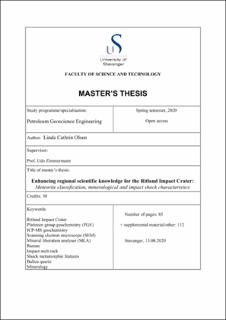| dc.description.abstract | Impactites from the Cambrian aged 2,7 km diameter Ritland impact crater in southwestern Norway were studied in detail using methods such as SEM (Scanning Electron Microscope), ICP-MS geochemistry, PGE (Platinum Group Element) geochemistry, MLA (Mineral Liberation Analyser) and Raman in a quest to classify the meteorite, study potential shock metamorphic features and to provide new insight into the mineralogy of the impactites. This thesis documents the presence of ballen quartz in the impact melt rock for the first time. Based on this, this thesis also provides a minimum pressure constrain of 30-40 GPa along with a minimum temperature of 1200 °C for the impact event. Zircons has shown granular textures for the impact breccia, which could be due to normal metamorphic processes or caused by the impact event. More research is needed for assertiveness of its origin, but if the granular textures is a consequence of the impact, further pressure constrains would be set to a minimum of 50 GPa. Titanite is abundant in the impact melt rocks and proven to be hydrated and to show oscillatory zoning of metamorphic origin. The presence of hydrated titanite, clinozoisite, chalcopyrite, sphalerite, cobaltpentlandite and pyrite along with extensive chloritization, biotite decomposition and plagioclase fractionation are strongly indicative of hydrothermal activity related to the impact event. Mineralogical indications of hydrothermal activity are present for all lithologies sampled within the crater rim and for the fractured and brecciated basement. No PGE anomaly is detected for the impact melt rocks, indicating an achondritic rather than chondritic origin of the impact body. The Raman results provided confirmation of metamict zircons and no polymorph detections. Impact melt rocks is composed out of microcline (58 wt%), quartz (19 wt%), albite (10 wt%) and biotite (5 wt%). Additionally, minerals common in all impact melt rock samples with bulk weight percentages < 2wt% are calcite, chlorite, amphibole, titanite, iron oxide, pyrite, zircon, apatite, monazite, plagioclase, stilpnomelane and allanite. Occasional occurrences of xenotime, galena, sphalerite, rutile, ilmenite (Mn-rich), cobaltpentlandite, clinozoisite and chalcopyrite is present for a varying amount of the impact melt rock samples. Plagioclase fractionation amounts to an abundance of 39 wt% of plagioclase (out of total light mineral concentration) to the unaffected basement while < 3 wt% for all other lithologies, which is instead dominated by K-feldspar (microcline). Highly detailed XMAPs is presented for all studied lithologies. Unfortunately, the COVID-19 situation prohibited further studies with Cr/Os isotopes and a series high-resolution microscopic methods (microprobe, transmission electron and helium ion beam microscopy). | en_US |

